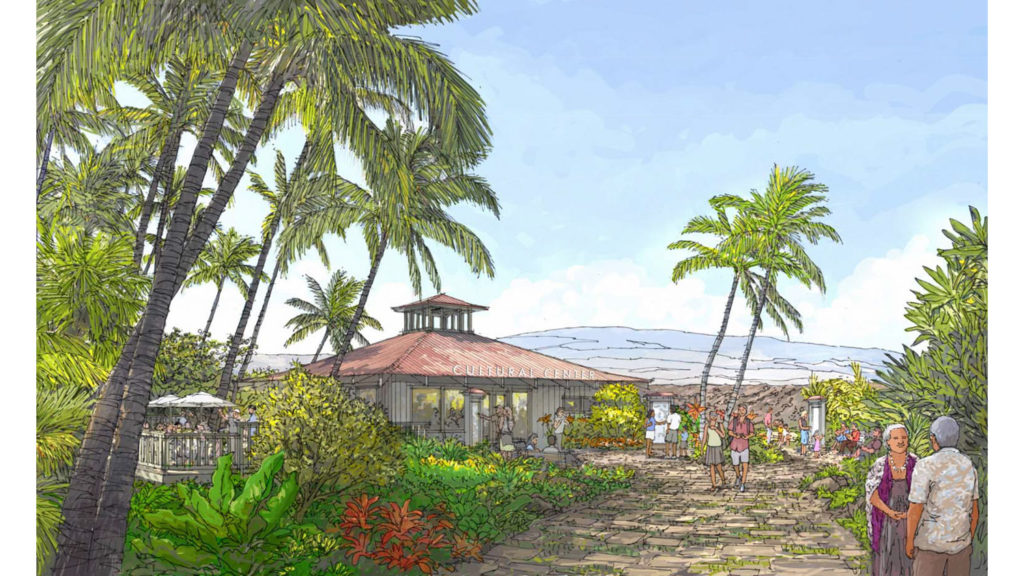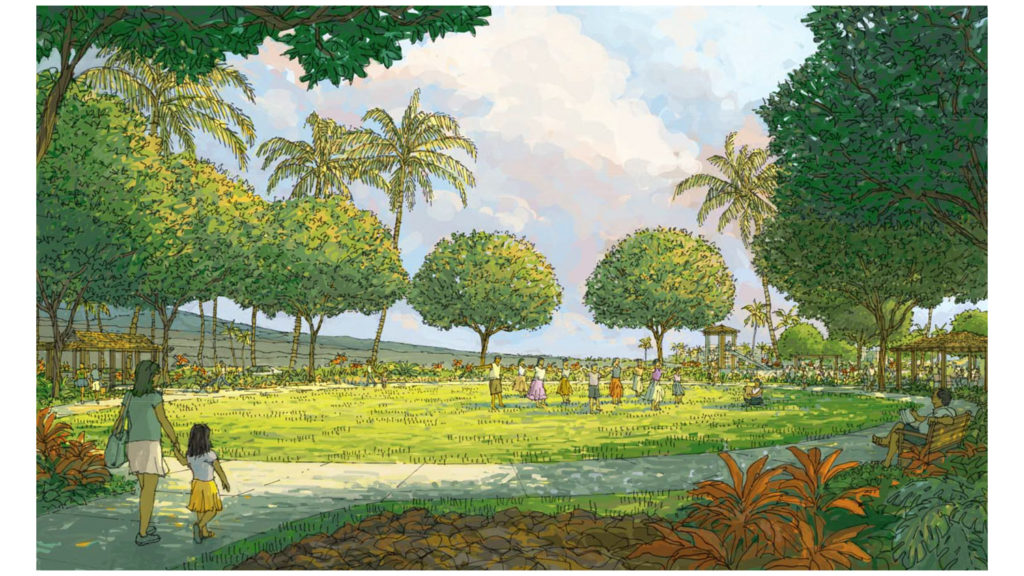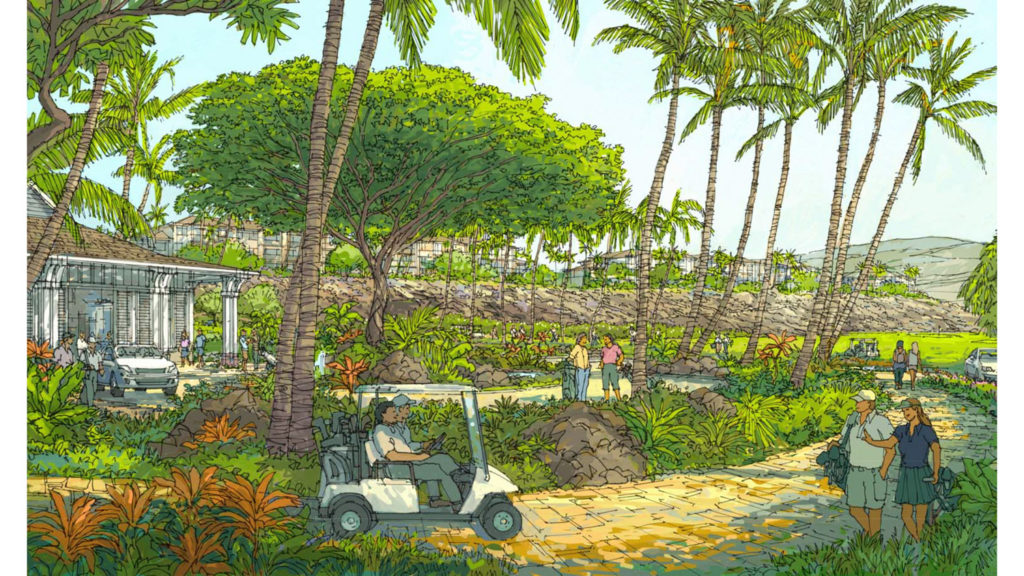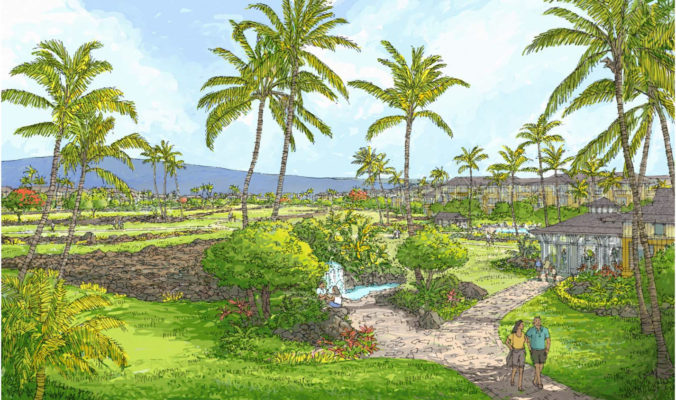Like any successful business, a resort must continuously evolve. Tastes change. Priorities shift. New generations have new perspectives. Back in the 1960s, for example, formal dining rooms with white table cloths serving French cuisine were considered the height of elegance, even in Hawaiʻi. At some resorts, if a guest showed up without a dinner jacket, one would be loaned. In the 1980s and ‘90s Hawaiʻi Regional Cuisine swept in, creating new culinary stars and a dining experience that was based on the uniquely multi-cultural identity of the islands. Nowadays, of course, dining is all about farm-to-fork with a strong and welcomed emphasis on locally-sourced foods.

SHIFTING PRIORITIES
When Waikoloa Beach Resort (WBR) was in its primary growth phase in the 1980s and 90s, golf was the driving force. Resorts and residential developments in the islands, as they were elsewhere in the U.S., were building golf courses as fast as possible, and opening “a course a day until the year 2000” was the National Golf Foundation’s projection of demand. To meet this anticipated need on Hawaiʻi Island, WBR opened the Beach Course in 1981 and the Kings’ Course in 1990.
And while golf still has an important place in Hawaiʻi’s economy and along the Kohala Coast — golfers tend to stay longer and spend more on average than other tourists — demand in the state has never met expectations. In fact, it’s no secret that golf has been in decline for nearly two decades nationally, with more course closures than openings for the last 13 consecutive years.
Throughout the Hawaiian Islands and beyond, golf play has declined dramatically over the past 25 years. Depending upon the year, Waikoloa has witnessed drops of up to 35 percent when compared to the highs play levels in the mid-90s. In 2002, more than 17 percent of Mainland visitors played golf during their visits; in 2018, that number had shrunk to 8.3 percent. It’s an unfortunate related fact that the Kings’ Course has never been profitable on its own and in many years has suffered sizable operating losses.
At the same time, there has been no such decline in demand for travel to Hawaiʻi, and tourism (pandemic year aside) is on track to set new records in the years ahead. What’s changed is that the consumer is looking for something different: family-oriented activities that center on the ocean, authentic cultural experiences, and a deeper understanding of the fragile Hawaiian environment.
The other seismic shift in priorities? The huge and growing demand for time-share units as they deliver exactly what families want: more communal space, kitchen and laundry facilities, the ability to own and pay over time, and the luxury of operating on a schedule entirely their own.

RENEWED PURPOSE
Waikoloa Beach Resort plans to deliver on this demand and plot a sustainable future at the same time with the Kumu Hou development, which in Hawaiian means “renewed purpose.”
“Our renewed purpose is to refine and evolve Waikoloa Beach Resort to meet the needs of today’s traveler and keep this iconic resort on top of its game for years to come,” says VP of Resort Operations Scott Head. “At the same time, we have always been committed to making the local community a better place, and Kumu Hou allows us to accomplish both of those critical goals.”
Included in the master plan — all within the existing footprint and density caps of WBR established by the state and county — are 900 new time share units, 25 new single family home sites, more than 140 badly needed affordable workforce rental housing units for kamaʻāina, a reimagined 27-hole golf experience, new open space parks and trails facilitating shoreline access, and an enduring endowment for the cultural and educational activities of the Waikoloa Foundation.
The first phase of the project will be the rerouting and rebranding of the WBR golf courses into a 27-hole facility with several new holes and a new, modern clubhouse. The new nine-hole loops will be called the Kings’ Nine, Beach Nine, and Lakes Nine.
“We are ‘right-sizing’ our golf facilities,” Head says of the reduction from 36 to 27 holes. “With consumer demand changing, this allows a much more sustainable use of land over the next 15-20 years. We worked with Hilton Grand Vacations on a plan that would protect all of their existing and future development golf course frontage.”
The land where the unused nine holes now exist will be repurposed to accommodate the 900 new time share units and 25 single family home sites.
“Time share has proven to be an extremely resilient sector, and these new units will help feed and sustain the 27-hole facility and keep it viable for generations to come,” Head says. “The units will also help support the existing retail, restaurant, and activities businesses that make Waikoloa Beach Resort unique.”
Economic impact studies estimate that the development of Kumu Hou will create between 260-520 full-time equivalent development-related and construction jobs each year; approximately 470 full-time equivalent jobs throughout Hawaiʻi Island and the State at completion; an estimated $10 million per year in net additional tax revenue to Hawaiʻi County; and from $9 million to $50 million in additional GET and TAT tax revenues to the State of Hawaiʻi.
Another point of emphasis is that although Waikoloa Land Company has already satisfied its affordable housing requirement for the entire resort, it is committed to providing additional affordable workforce rental housing units on an existing zoned parcel within the confines of the resort as part of the Kumu Hou project.
“This may be the first affordable housing project within a master planned resort community in the State of Hawaiʻi,” Head says. “Waikoloa Land Company sees the need and wants to provide an opportunity to improve the quality of life for our residents and island families.”
Existing businesses and employers at WBR will also beneficiary by having nearby affordable workforce housing.

A FOUNDATION FOR THE FUTURE
But perhaps the most important contribution the Kumu Hou project will make to Hawaiʻi island will be a sustaining endowment for the Waikoloa Foundation, supported by dedicated funds from sales of the new timeshare units. A total possible contribution of between $40 million and $50 million is expected to be funded during the sales period for initial transactions, projected between 2027 to 2042.
The Foundation, which fulfills a commitment made long ago by the resort’s original visionary developer, Ron Boeddeker (1938-2010), to support the Hawaiian community, its culture, and the environment, is one of the most important legacies of Waikoloa Beach Resort.
Boeddeker created the Waikoloa Foundation with a mission “to preserve and support the unique cultures and environments native to the Hawaiian Islands.” These longstanding beliefs have taken on greater urgency these days as the state and island rethink tourism’s impact and how best to manage such an integral segment of the state’s economy. That’s why, in 2020, Boeddeker’s daughter, Cary Boeddeker, relaunched the Foundation with fresh programmatic priorities.
“We are one of the oldest resort ownership entities in the Hawaiian Islands,” she says. “We’ve been here for more than 40 years now. This is not the norm, as hotel and resort investors are not often here for the long term. By contrast, we’ve been growing with and supporting the local community for a very long time. I’m so grateful I have this chance to perpetuate the legacy my father began when he started the Foundation back in 1987. Waikoloa — the place and its people — represents a remarkably special kuleana that we are proud to carry forward.”
As board chair for the Foundation, Boeddeker is supported by a board of directors that now includes Nani Lim Yap, Margo Harumi-Mau Bunnell, Ed Teixeira, David A. Honma, Kanani Aton, Scott Dodd, Rob Pacheco, and Judith “Judi” Jennet, a group that represents diverse aspects of the island community from culture-based education to conservation and land use issues to ocean expertise to the business community.
Plans are underway to convert the historic Parker Ranch recreation building — located near Anaeho`omalu Bay — into a Waikoloa cultural resource center and Foundation headquarters. With the conversion slated to begin in the near future, the building will be the new home for cultural programming and education, and historic preservation at Waikoloa.
Currently being used as the administration office for Lava Lava Beach Club, Boeddeker says a total redesign of building’s use is in the works, and the addition of several educational elements such as teaching and video rooms.
Cultural sites the Foundation will focus on include the resort’s prolific petroglyph fields, its unique anchialine ponds, and the portion of the Kings’ Trail that runs through the resort, where recent efforts have included new signage.
“Kumu Hou is not just about a single resort evolving to meet the needs of a new consumer,” Head concludes, “although it achieves that goal as well. But it is about the broader economic and cultural health and well being of the Hawaiʻi Island community, and a commitment by Waikoloa Beach Resort to a far more sustainable future in tourism.”

